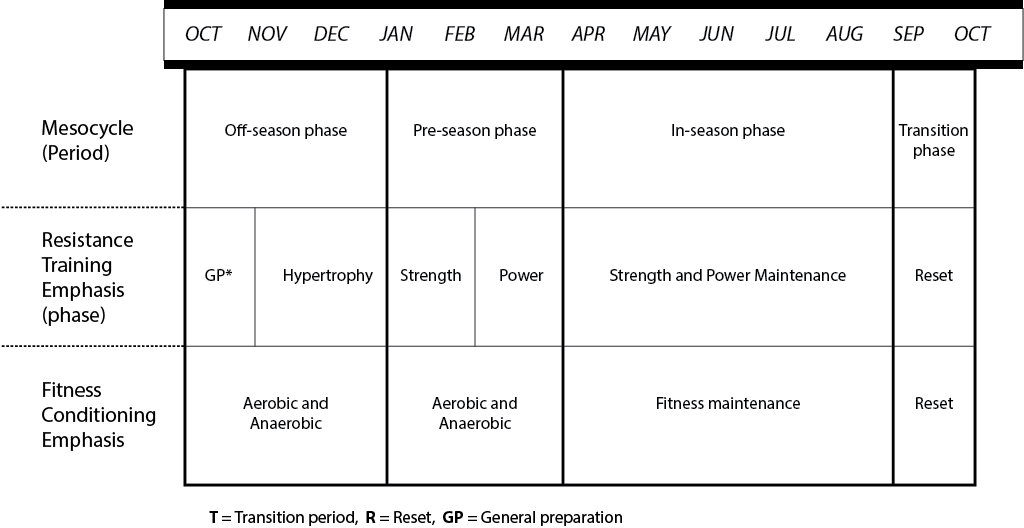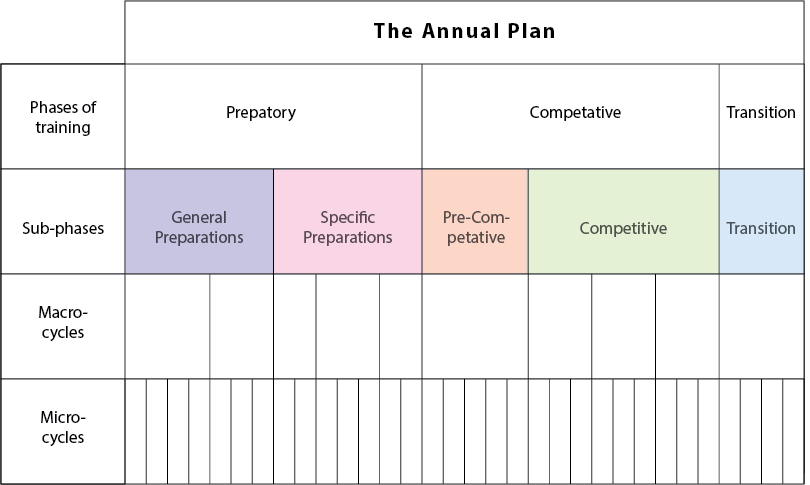Content
- Periodisation and the training year
The training year was split into pre-season, in season and off season and the methods and types of training reflected the sport and the particular time of year e.g. high volume (the amount of training), high intensity training within pre-season.
Traditional linear periodisation is a widely accepted method of structuring training programmes to produce maximum performance at the right time, also known as peaking. This type of periodisation is widely used by athletes, swimmers and cyclists building fitness towards a specific event such as the Olympics.
A training program is usually planned with three specific periods - the Preparation Period, Competition Period and Transition Period. The aim of periodisation is to peak for a specific competition and develop a specific component of fitness. As the macrocycles progresses then volume of training is reduced with greater emphasis on intensity specific to the event or components of fitness. E.g. speed - developed as a result of high volume mesocycle of strength with a higher intensity lower volume mesocycle of power. The final mesocycle then focuses of specific speed development at maximum race pace. Some linear programmes have dual periodisation models whereby the training is focused on two main events or competitions. The order of training is the same as normal periodisation but in shorter blocks.
As the title suggests, this is a period of training that lays the foundations for the main competitions. This period of training is characterised by the volume of training, which gives you the necessary base levels of skills and fitness required for the competitive phase. E.g. A sprinter would build strength during the preparatory phase in order that there is power development in the competitive season with specific speed development when peaking for a competition.
A transition phase from general skills and fitness to more sports specific movements and actions as well as improving and perfecting technique and tactics e.g. Working on your agility in netball as well a centre pass routines
The main task should be the consolidation of all training factors, which allow the athlete to compete successfully in the main competition. During almost all of the training is related to sport-specific movements, while the other focusses on general conditioning and maintenance of skills and fitness.
A phase characterised by non-competitive activities. This phase is important because while muscular fatigue will disappear in a week or so for most trained athletes, neural central nervous system fatigue can remain for a much longer period of time. The transition phase incorporates rehabilitation, which allows the athlete to recover from any injuries and psychological relaxation.
The training plan is usually developed from the first week of training of the new season until the last competition of the season. With the start and end point established within the year, the total time is then divided into microcycles. The microcycles are grouped in mesocycles and the mesocycles grouped in macrocycles
These are then assembled into phases to complete the training plan.
The duration of the cycles is very much dependent on the sport, and the competition the athlete is training for. The following timescales reflect this.
A microcycle is usually between 1 to 14 days
A mesocycle is usually between 2 weeks to 6 months
A macrocycle is usually between 1 to 4 years
Duration = 1 week
The easiest way to prepare the microcycle plan is to use a one week (7 day) microcycle. Each microcycle should be planned to incorporate recovery times between each training session.
An example of a microcycle for a seventeen-year-old power/speed athlete (jumps, throws, sprints and hurdles) training once per day during the Preparation Phase might look like this:
| Monday | Tuesday | Wednesday | Thursday | Friday | Saturday | Sunday |
| Weight training | Skill, training & technique | Speed endurance | Weight training | Rest, flexibility | Skill, Speed, Speed endurance | Weight training |
The easiest way to prepare a mesocycle is to group together 2 to 4 microcycles in a particular phase. As in the microcycle, recovery has to be planned into the mesocycle. Usually, the last microcycle is a recovery week with the volume of training reduced.
A macrocycle is a group of mesocycles. It is the all of the training that is carried out for that full cycle e.g. 1 year.
Using an example of an annual training plan (Macrocycle) the phases and cycles are usually grouped as follows with the microcycles in the bottom row. In reality for a power athlete such as a discus thrower building for a specific event in the competitive section (season) the training could follow this pattern:
Preparation Mesocycles – Initial development of muscle hypertrophy in preparation for strength training
Special Preparation Mesocycles – Development of strength in preparation for power training
Competitive Mesocycles – Power development in preparation for speed (specific to discus
Peaking for Competition – Focus purely on power and speed of movement
Peaking for Competition – Focus purely on power and speed of movement
An example of this is seen in the graph below:

http://www.sarugby.co.za/boksmart/pdf/BokSmart%20%20Physical%20conditioning%20for%20rugby.pdf
An example of a yearly plan (Macrocycle) including all Mesocycles and Microcycles

Periodisation was initially designed for Olympic weight lifting which is a sport that only uses two principle components of fitness i.e. strength and power. It has also been widely used in athletics and swimming where the goal is to peak for a particular event or competition. Team games such a rugby and netball provide the problem of a relatively short preparatory phase (pre-season) with a long competitive stage i.e. a nine-month season. With the length of the season so long it is impossible to peak for every week or match of the season. Therefore, the in-season or competitive period is focused towards the maintenance of fitness with the possibility of small gains. A further problem then arises as to when a team should aim to peak in a season. national coaches would want to peak for the internationals and major competitions, while club and coaches would want to peak for the final rounds of domestic league or cup competitions. Hence there is a potential conflict in this particular instance.
Further issues arise within the very nature of team sports. For example, within rugby union, many different physical and skill related components of fitness are used. These can range from strength and power, aerobic fitness to agility. This provides a problem in itself in the fact that a balance has to be reached in order to develop all of the components. On top of the specific strength and conditioning, there are game specific skills e.g. handling and contact skills, which are even more essential for successful players.
An example of a general periodised training programme for a rugby union player:
| Month | May | Jun | Jul | Aug | Sep | Oct | Nov | Dec | Jan | Feb | Mar | Apr | |
|---|---|---|---|---|---|---|---|---|---|---|---|---|---|
| Peroid | Off-season | Pre-season | In-season or competition period | ||||||||||
| Aerobic work | Develop | Maintain | |||||||||||
| Anaerobic work | No specific | Develop | maintain - attempt to develop if periods of inactivity are present | ||||||||||
| Strength | Non-specific | Strength endurance | Max-strength | Rate of force development | Max-power | Speed strength | Max-strength | Rate of force development | Max-power | Speed strength | Maintain | ||
| Speed | No specific work | Emphasis on technique | Top end speed | Acceleration | Agility | Game specific | |||||||
| Volume | Low | Trend high start lowering towards season | Volume will be lower tahn pre-season but may increase during periods of downtime/injury or non-competition games intensity need to remain high will decrease if volume increases | ||||||||||
| Intensity | Medium | Trend med increasing towards season | |||||||||||
| Monday | Tuesday | Wednesday | Thursday | Friday | Saturday | Sunday | |
|---|---|---|---|---|---|---|---|
| AM | Speed and acceleration | Anaerobic small intervals | Whole body strength | Recovery day | Anaerobic long intervals | Skills | Recovery day |
| PM | Whole body strength | Aerobic training | Upper body strength | Anaerobic games |
http://www.mwsu.edu/student-life/organizations/rugby/pdf/Fitness-for-Rugby.pdf
| Monday | Tuesday | Wednesday | Thursday | Friday | Saturday | Sunday | |
|---|---|---|---|---|---|---|---|
| AM | Speed and skills | Skills | Strength Miantenance | Power | Team run | Game | Recovery day |
| PM | Strength and maintenance | Anaerobic | Skills | Pool recovery | Pool recovery |
http://www.mwsu.edu/student-life/organizations/rugby/pdf/Fitness-for-Rugby.pdf
Performers have to develop their physical fitness and skill levels for competition.
(a) Explain how an athlete can use periodisation to refine their performance. Providing examples support your answer.
(8 marks)
Indicitive content
Max 5 marks for explanation of periodisation
3 marks for practical application and use of examples